This paper is available in Français too
Based on its expertise in DSP and finite impulse response (FIR) with the ensuing success of its DSR series, YAMAHA hit the nail on the head by launching its DXR range of speakers on the compact sound distribution market. Speakers boasting the same processing technology but offered at an even keener price.
This new family comprises four models which share the same electronics and the same small tweeter. Christened DXR 8, 10, 12 and 15, it is therefore basically the number suffix representing the size of their woofer, which differentiates them.
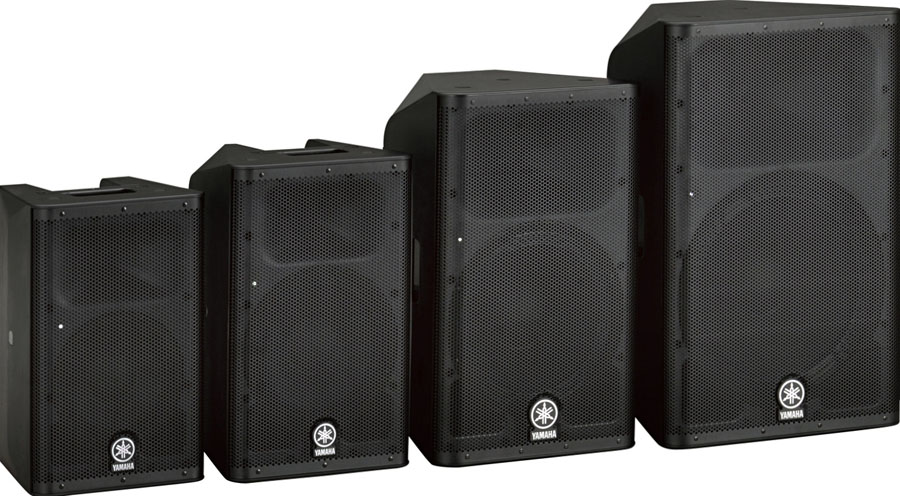
To complete the range, two subwoofers, the DXS 12 and 15 have been especially created in order to meet the specific low frequency needs of the music scene and of small-scale events.
Production
Enclosure
The DXR models are moulded in matt black non-resonant ABS enclosures that are both attractive and discreet. They are equipped with heavy-duty honeycomb grilles with sufficient openwork to catch a glimpse of the front of the diffuser. The constant directivity dispersion horn, which is nearly identical to that of the DSR range, can also be clearly distinguished. Below is the boomer with at its base the two triangular ports of its bass reflex charge.
The brand-new enclosure design combines a trapezoidal base with a vertical wall structure with an hexagonal cross section. The general shape, with its sleek lines and sharp edges attracts attention. Visual perception, depending on viewing angle and ambient lighting, varies between truncated prism, convex polyhedral or simple parallelepiped. Beyond being pleasing to the eye, the truncated sides on the back of the loudspeakers have been optimised in order to allow for foldback on stage. In this case the projection angle with respect to the floor is 50°. Remarkably, only the DXR 8 does not allow this type of use due the simplified design of its shell.
Implementation system
Each enclosure integrates numerous fittings that facilitate implementation and operation. The base, fitted with four robust rubber feet, has two 35-mm base plates for standard feet. One is positioned perpendicular to the base plane, the other one is tilted at an angle of 7 degrees. This site value is relevant to the majority of small auditorium topologies. Once the speaker is mounted on its base, the tilt allows the optimisation of sound projection towards the audience and the minimisation of specular reflection from the ceiling or other reflective surfaces, for example upstage. Compared to the DSR range, which does not have this option, it is a true bonus. However, there is no system for locking the rotation of the enclosure.
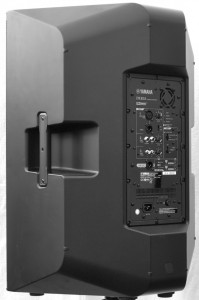
As regards mounting, three rigging points on the top and at the back of the enclosures allow the speakers to be suspended by a conventional sling system. Yamaha also offers an optional bracket that can be mounted in both vertical and horizontal configurations on the enclosure and allows tilt and pan adjustment of the speaker.
In order to facilitate transport and handling, a single aluminium handle has been judiciously placed at the top of the 8 and 10 inches, whilst for the larger DXR12 and 15, two handles were deemed to be necessary. They are built into a housing on the sides and are ideally placed within the weight distribution of the speakers and provide sufficient prehension to allow for the installation of the speaker on a tripod pole. Warning! Even if this operation can be carried out by one person, it is highly recommended that you ask for help, notably for the DXR 15 and its 22 kg.
At the back of the speaker, built into its special housing, the monobloc electronics box can be found. At the top, the ventilation louvers indicate the presence of a 4-speed forced ventilation system controlled by a thermal regulator.
User interface
The control and connection panel, easy to read and complete, provides a number of functionalities, which can be listed in two distinct parts: an analogue mixer and a control interface for the DSP.
Small mixer
Intelligent, it can handle up to three simultaneous inputs. The first in XLR links with interchangeable input sensitivity at line level (+4 dBu)/mic level (-30 dBu). When in MIC position, input 1 was primarily intended to handle voice signals, the HPF (high pass filter) is automatically inserted. It is to be noted that no phantom power is added and that the THRU output with male XLR is simply wired in parallel before processing. Double inputs 2 (jack) and 3 (RCA) accept stereo signals from the so-called “general public” equipment (-10 dBV). Each source has its own power adjustment but the nature of the mix sent to the DSP is mutually dependent on the LINK MODE switch. In mono mode, it is the mix from input 1 with the selectable mono of inputs 2 and 3, which is sent to both DSP and DXR LINK output. In stereo mode, the mix from input 1 with only the left channels of inputs 2 and 3 feed the DSP. Simultaneously, the mix of the right channels for inputs 2 and 3 for its part, is sent to output LINK in order to be redirected to a second speaker. Such a system allows the creation of a simple stereo output without additional equipment.
Control and DSP interface.
- Filtering
In order to optimise the frequency link with the new subs DXS12 and DXS15 or with those of the superior DSR118 range, the user has two HPFs of the 4th order switchable to either 100 or 120 Hz.
A dynamic D-Contour filter with two distinct adjustment configurations has also been implemented. In FOH/MAIN mode, the DSP uses a physiological treatment to compensate when listening at low levels for the lack of sensitivity of the human ear with respect to the top and especially the bottom of the audio spectrum. The never-before-seen MONITOR mode is aimed at linearising the low register response by compensating for the interfering floor reflection whenever the speaker is used for foldback.
- Signalling
In addition to a specific start-up LED, the speaker has three further indicator lights signalling respectively: shutdown of the speaker in the event of malfunction, detection of audio signal and start-up of limiter. Incidentally the latter signalling and powering information are repeated on the front of the speaker by an LED with dual function that the operator can deactivate by means of the “FRONT LED DISABLE” switch.
Transducers
HF
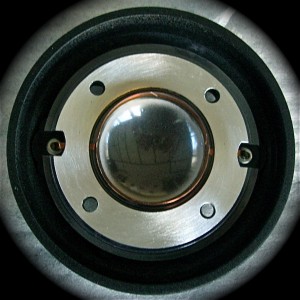
Highly conventionally, the high notes are entrusted to a tweeter coupled with a 1 inch closed diaphragm. The Mylar diaphragm peripherally supports the 35 mm coil supplied by a 150 W amplifier. This small motor that is fitted in the entire DXR family, is able to reach to 20 kHz without weakening. Unfortunately its low cut-off frequency between 2.1 and 2.4 kHz depending on the model, is, in my opinion, much too high to hope for a satisfactory directivity crossover for a 15 or even 12 inch boomer with the high-frequency horn.
BF
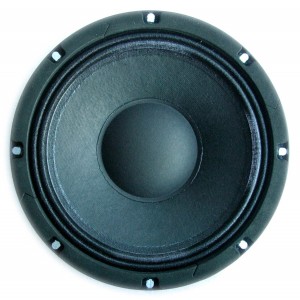
Securely fixed to the front with 8 Phillips screws, the 8-15 inch speakers are simple and traditional creations.
Equipped with a pressed metal basket assembly, an impressive ferrite magnet with central and peripheral air shaft, a cone-shaped paper membrane provided with a half-roll oilcloth suspension, these transducers with their tried and tested technology are fitted with a 2 inch coil for the 8 and 10’’ and 2 1/2 inches for the 12 and 15’’. Able to absorb 950 W of dynamic power, these transducers can provide peak acoustic pressures between 129 and 133 dB SPL.
Electronics
Various modules
The monobloc and compact electronic housing is a model of successful integration. It groups together no fewer than six distinctive printed circuits.
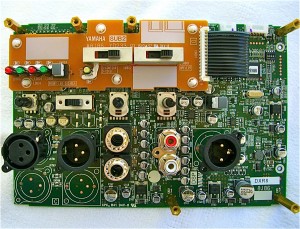
The one dedicated to both the analogue mixer and DSP is protected from electromagnetic radiation by a metal shieldμ notably with respect to the universal power supply (100 to 230 V). It uses a new cutting method in order to meet the power needs represented by the 1100 W of the Class D amplifiers.
Past the 24-bit conversion, the DSP takes charge of all of the signal processing up to the power amplifiers. Calculations are carried out in 48 bits with 76 bit accumulation. All of the audio processing, notably crossover, multi-band parametric equalising, inter-transducer compensation delay and limiters are configured in a factory memory specific to each DXR model.
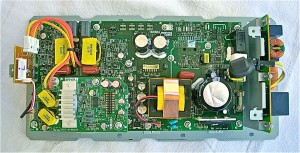
Digital crossovers providing linear phase response use FIR X tuning ™ technology. Crossover frequencies have been very precisely set at : 2.4 kHz for the DXR8; 2.3 kHz for the DXR10 and 2.1 kHz for the DXR12 and 15.
Safeguards
A protection system controlled by a special microprocessor and by the DSP permanently monitors the status of the power supply, of the power amplifiers, of the transducers as well as the audio signal level throughout the processing chain. If a fault is recorded, this system kicks in and the speaker is deactivated. This is notably the case for overheating, detection of short-circuit, or overvoltage in power grid.
When the DXR is powered, the protection system is active in order to avoid any switching noise in the speakers. Its indicator lights up for approximately two seconds and turns itself off once the regulated voltage is established.
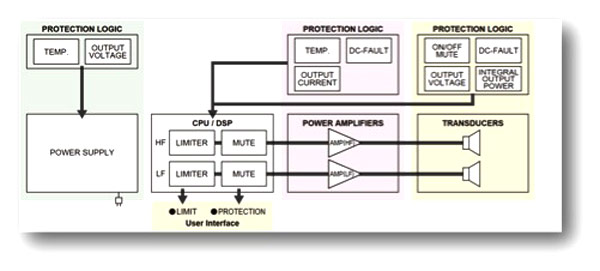
Measures
Measure in axe
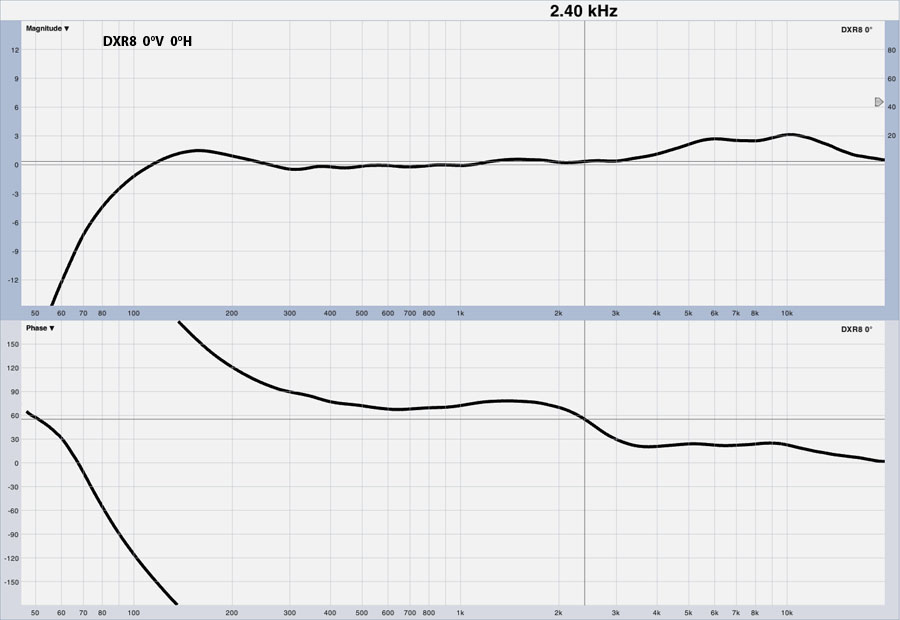
The fine-tuning of the DXRs was entrusted to engineers at Nexo, Yamaha’s French partner. Regarding the amplitude/frequency curve, a slight pre-emphasis of the high notes is recorded, which is there to compensate for the inevitable weakening observed outside of the axis of the horns and allows to display an average response, for the entire coverage area, confined to a limited size as we will be able to see a little later.
In the low register, the small DXR cuts progressively and very regularly from 90 Hz. Its bandwidth at -10 dB drops to 60 Hz.
Crossover uses FIR-X technology and should have displayed a totally flat phase curve in the connection area. Yet the curve reveals the presence of two horizontal plateaux indicating a very slight phase delay, 60° to be precise, equivalent to 1/6th wavelength. This delay corresponds to a difference in acoustic pathways between woofer and tweeter of approximately 3 cm. It can be inferred that the tweaking of the inter-transducer propagation delay was carried out in the line of the horn and not in the middle of the speaker’s centre line.
Treatment measures
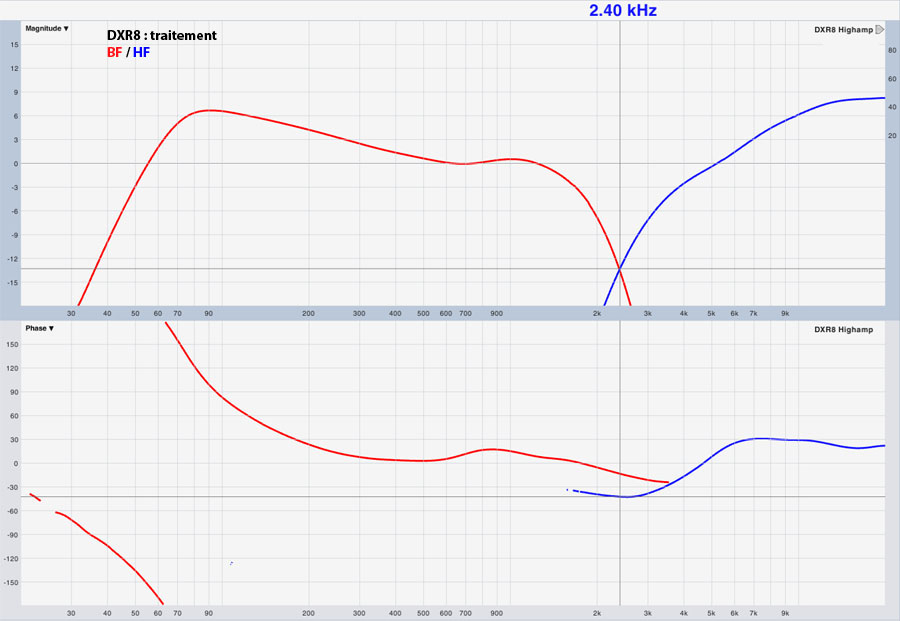
This in no way spoils the excellent results achieved by the Nexo engineers, who were able to judiciously take advantage of the DSP resources for fine-tuning the DXR. The curves in Figure 10 represent the conformation treatment applied to the audio signal for high and low frequency bands.
Horizontal directivity
The DXR8’s horizontal directivity behaviour is controlled correctly in the 90° of the announced dispersion angle.

The constant directivity horn displays good efficiency up to 14 kHz. Beyond this, the response drops but nonetheless remains consistent up to 20 kHz.
The woofer’s directivity is said to grow, which means that it increases with the frequency. After 500 Hz, at the nominal DXR dispersion angle, i.e. 45° outside of the axis, the response drops inexorably. This loss, which should prove to be more significant is minimised here as a result of the considerable equalisaton applied to the low frequency band. With this treatment, the connection at -6 dB between boomer and horn is near-perfect. The red curve represents the average of curves recorded from 10 to 10° horizontally. It is held in a 0/-3 dB template on a band between 80 Hz and 20 kHz.
Vertical directivity
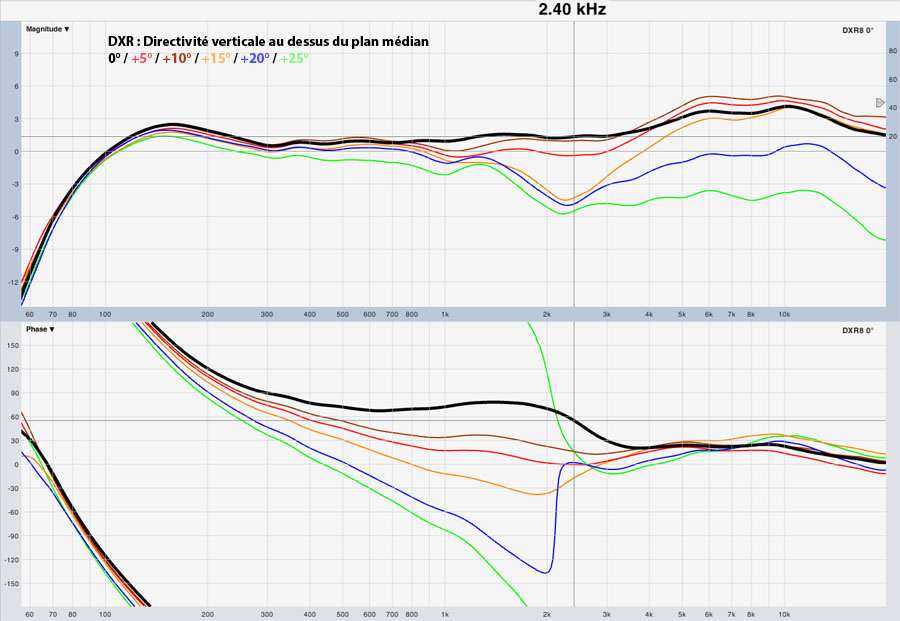
Above the horizontal median plane, the measured response curves undergo more or less significant disruptions due mainly to two very distinct phenomena, which should be differentiated :
- The difference in acoustic pathways between tweeter and woofer lead to noteworthy interfering behaviour in the recovery zone of the crossovers. The use of filters based on FIR technology with considerable slopes nonetheless minimises the relevant bandwidth. On the DXR, it does not exceed 1/3 of an octave centred on the crossover frequency.
- The attenuation in the medium band observed from 1500 Hz is the result of the hyper directivity of the woofer at these frequencies, since the recovered energy outside of the propagation cone becomes insufficient to perfectly connect with the horn.
In practice, the importance of these measurements carried out above the horizontal median plane should be rationalised since once the speakers are placed on their tripod pole, the audience will be seated under this median plane most of the time.
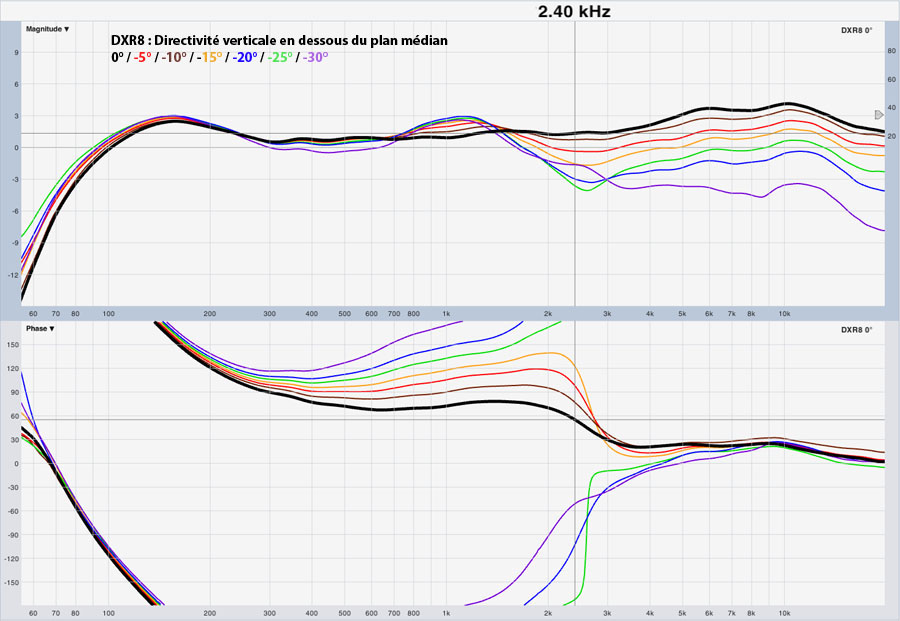
Below the median plane, the response network is also disrupted but to a lesser degree.
From 3 kHz to 20 kHz, the curves are strictly parallel, showing the excellent vertical behaviour of the constant directivity horn.
Below this, the recovery zone experiences disruptions similar to those observed in the positive vertical place, then the curve dips to join a remarkable bump around 1 kHz. The latter, as a consequence of the previous explanation involving the woofer’s directivity, is directly linked to the increase in sensitivity measured in a speaker’s propagation cone.
Regarding vertical directivity, the +15 to -25° curves are held within more or less 3 dB over the entire 80 – 20000 Hz band. This is an excellent performance if account is taken of the difficulty to keep such a size during the design of a 2-way non-coaxial speaker.
Filter measurements
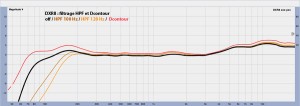
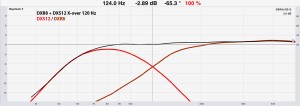
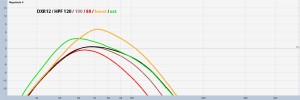
Besides the dynamic D-CONTOUR filtering treatment, the DXR has HPFs of the 4th order switchable to either 100 Hz or 120 Hz. These of course complement the filters on the bass boxes DXS 112 and 115. The recombination is perfect and the bandwidth at -10 dB drops to 47 Hz.
With the filtering method options offered on bass boxes, this band can be further expanded.
Listening
Words…

A Beta 58 in input 1 on the DXR, and let’s go for the voice test.
First pleasant surprise, despite physical differences, the tone perception regardless of the speaker listened to is remarkably similar. In the line of the speakers, it is even rather impressive since this similarity affects the entire voice spectrum. The latter is full of warm low notes and discernable high notes but a little less pronounced than on the DSR.
Moving in the horizontal plane confirms the excellent control of the constant directivity horn. The high mid-range and high components remain balanced. On the other hand, a little lower, around 1 kHz, the woofer loses some of its splendour, all the more so since the limit of the field angle is being approached. This phenomenon on the DXR 12 and 15 is much less marked on the small DXR 8 and 10.
Placed in foldback position, the three large DXRs offer an impressive potential acoustic gain without resorting to external equalisation. The use of the D-CONTOUR monitor minimises the usual low medium masking effect and improves intelligibility to the detriment, however, of fullness. Singers should be delighted. Bass players and drummers, for whom the foundation is important, a little less so.
… and music
Musical tests confirm the good impression left by the voice test. The sound is full with a balance between harmonics and fundamentals, attacks and resonance. The signal processing signed Nexo provides an identity common to the four sisters. Their tonal behaviour is similar except of course on full power where for the reproduction of low tones the DXR8 quickly shows its limitations. It has to be agreed, the laws of physics are implacable and, except for having a clearance 3.5 times greater than the membrane on the DXR15, the small 8 incher, with the best will in the world is unable to compete with its bigger sister in terms of power.
Conclusions
With this series of efficient speakers, Yamaha makes FIR technology available to everyone. The quality of their sound rendition and the acoustic power they are able to deliver result in the fact that they have no cause to be jealous of many speakers used by professionals. On the other hand, the ABS enclosures, the integrated mixer and the very convincing prices, prove to be decisive arguments to seduce the market for musicians and mobile discos, even that of small-scale events.
When faced with the number of models on offer, the most difficult task is certainly the ability to make a choice. If the intended use is a sound system for conferences or the playing of background music, the DXR8 with its compactness, its light weight, its consistent coverage, probably represent the best possible choice. On the other hand, if the goal is to play music on the dance floor, or to provide a drummer with an ultra-powerful stage foldback, it would be best to go for the large model in the range.
Between the two, the DXR 10 and 12 would be adequate to equip rehearsal studios or even small jazz clubs.
Lastly, let it be known that a triphonic system made up of a pair of DXR8 and a DXS12 bass box, is able to deliver force and bandwidth equivalent to that of two DXR15. This alternative is to be considered if, during your next beach tour, space in the back of the Renault Kangoo is at a premium.
Manufacturer’s specifications:







